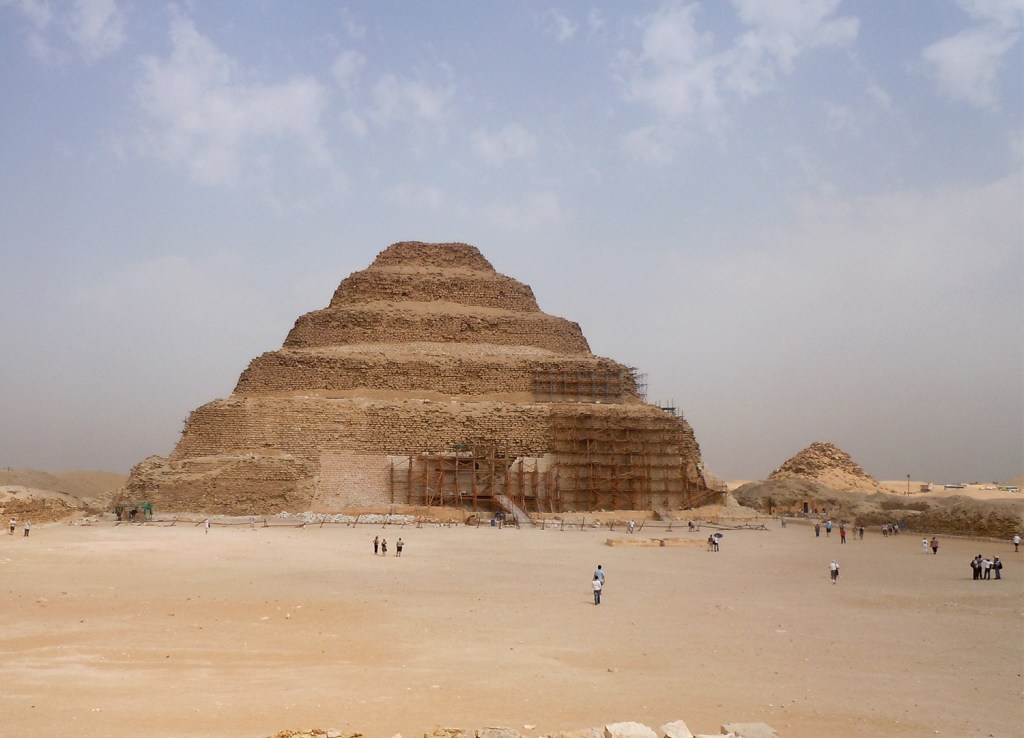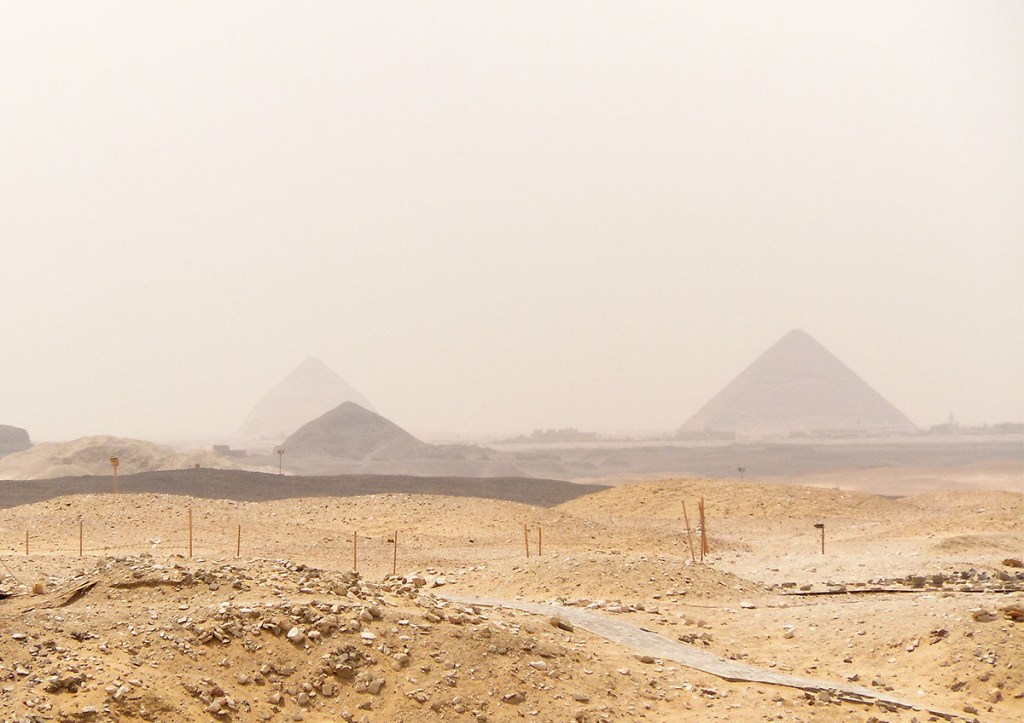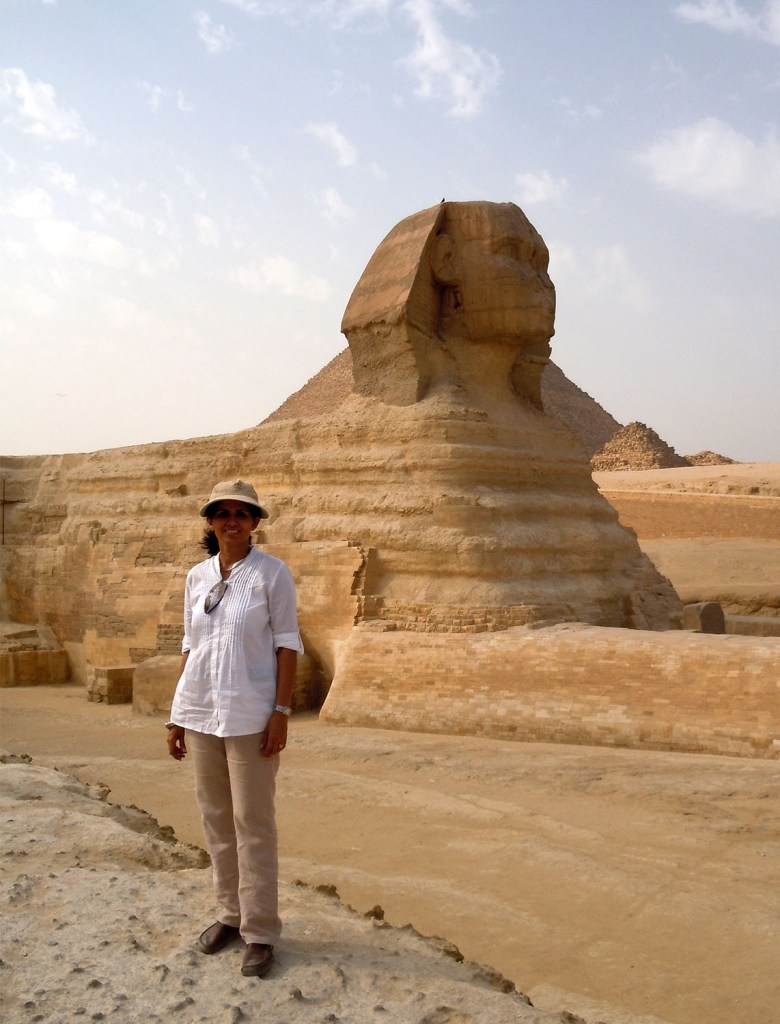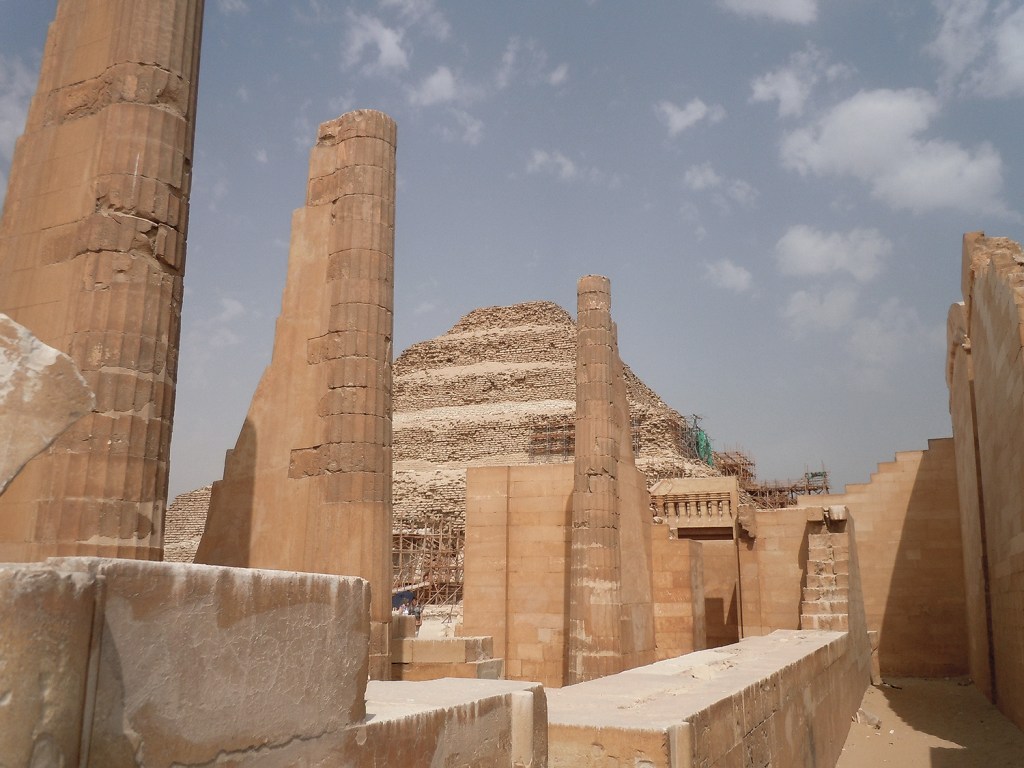UPDATED: April 2023
The first sight of the Pyramids of Giza emerging from the dusty haze of the desert is hard to describe. We were both dumbfounded by their mammoth proportions and the miracle of their geometry. And the advanced knowledge of the ancient civilisation that mastered it thousands of years ago. How on earth did they do it?!
Khafre’s pyramid in Giza – cleverly built on higher ground – appears larger but the Great Pyramid of Khufu (or Cheops), son of Snefru, is truly awe inspiring. My images barely do its scale justice. The considerably smaller pyramid of Menkaure takes a back seat.

THE GREAT PYRAMID – ASTOUNDING FACTS
Let’s try and wrap our heads around the unbelievable specifications of the Pyramid of Khufu.
- The sole remnant of the Seven Wonders of the World, the Great Pyramid of Giza, is one of the oldest structures in existence.
- It was the tallest building on earth for over 3800 years.
- A total of over 2,300,000 blocks of limestone were used in its construction with the average block weighing 2.5 tons.
- Construction date (Estimated): 2580 B.C.
- Construction time (Estimated): 20 years.
- Total weight (Estimated): 6.5 million tons.
- The four sides align perfectly with the four cardinal points.
- The base of the pyramid covers 13 acres, and the length of each side was originally 755.9 feet, but is now 745 feet.
- Each side has an area of 5 1/2 acres.
- The original height was 480.6 feet tall but is now only 455.4 feet.
- The majority of the outer casing of polished limestone was removed about 600 years ago to help build cities and mosques.
- The ratio of the perimeter to height of 1760/280 cubits equates to 2π (Pi) to an accuracy of better than 0.05% (corresponding to the well-known approximation of π (Pi) as 22/7). Verner wrote, “We can conclude that although the ancient Egyptians could not precisely define the value of π (Pi), in practice they used it.”

Ricardo Liberato, CC BY-SA 2.0, via Wikimedia Commons
AND EVEN MORE THEORIES…
The outside casing stones are cut within 0.01 (1/100th) inch of perfectly straight and at nearly perfect right angles. And they were placed together with an expansion joint of 0.02 inch.
All four sides of the Pyramid are very slightly and evenly bowed in, or concave. This effect, which cannot be detected by looking at the Pyramid from the ground, was discovered around 1940 by a pilot taking aerial photos. As measured by today’s laser instruments, these perfectly cut and intentionally bowed stone blocks duplicate exactly the curvature of the earth!
The north-south axis (31 degrees east of Greenwich) is the longest land meridian, and the east-west axis (30 degrees north) is the longest land parallel on the globe. There is obviously only one place that these longest land-lines of the terrestrial earth can cross, and it is – incredibly – at the Great Pyramid! (Fact – very marginally off @ 29° 59′ N, 31° 09′ E).
Using existing ratios, calculations of the length of the year is expressed as the present and universally agreed 365.2422 days, accurate to 8 digits. Remember that the actual length of the year when the pyramid was constructed was not the present 365+ days, but 360 days.
The three Pyramids exactly simulate the stars Delta Orionis [Mintaka], Epsilon [Alnilam], and Zeta [Alnitak] that comprise the Orion Belt.
If we take a cross-section through a pyramid we get a triangle. If the pyramid is the Great Pyramid, we get the so-called Egyptian Triangle. It is also called the Triangle of Price and the Kepler triangle. This triangle is special because it supposedly contains the ‘Golden Ratio‘ (The ratio of the slant height to half the base) considered a near impossible feat.
Our feeling of reverence is justified.
THE GREAT SPHINX

The Great Sphinx, one of the oldest and largest monolithic statues in the world, is even more impressive in reality than it appears in pictures. There is no record of its original name and it is still not established conclusively as to who built it and what exactly it symbolises. It was the early Greek explorers who first referred to it as a sphinx after the half human, half lion character from their mythology with eagle’s wings.
A diorite statue of a seated Pharaoh Khafre – with a falcon symbolizing Horus behind his head – was found in Khafre’s Valley Temple beside it. That statue, now in the Egyptian Museum, adds weight to the general consensus that its face is the likeness of Khafre.
The valley temple was carved out of the bedrock quite like the monolith sculpture, but its surfaces are completely clad in pink granite transported all the way from Aswan!
The hypostyle hall of the temple leads to a doorway from where you get a dramatic view of the Great Sphinx. It is cordoned off, unfortunately, and visitors are only allowed to view it from within a narrow space on its right that gets crowded pretty fast.
LESSER PYRAMIDS & TOMBS IN THE GIZA PLATEAU
The Giza complex has several more satellite pyramids and tombs referred to as the Queen’s pyramids. The tomb of Queen Meresankh, wife of Khafre (or Menkaure!) with beautifully carved and painted scenes of her royal family in the inner chambers is now open to the public. Here’s a virtual walkthrough.
The eastern cemeteries are dedicated to the close relatives of Khufu & the western cemeteries to high ranking nobles and priests involved with the building and maintenance of his pyramid.
DAHSHUR, SAQQARA & MEMPHIS

Giza, Dahshur & Saqqara are part of the greater Memphis necropolis. Memphis was an important city through out the history of Ancient Egypt from its founding in 2920 BC by King Menes right up until the rise of Christianity in the 1st century AD.
Many Pharaohs ruled from this city and had impressive monuments constructed for themselves even after they moved the capital south to Thebes (modern Luxor). Alexander the Great had himself crowned Pharoah here. In fact the name Egypt is believed to have been derived from the Greek name for Memphis: Ai-gy-ptos.
It isn’t surprising, therefore, that some of the most impressive funerary monuments in the world are scattered around the area. Mainly in the greater Saqqara necropolis and in Giza. Alexander was also buried in Saqqara briefly before his remains were moved and lost forever.
The city itself is completely in ruins. The main surviving attractions there are a monumental ten meter long fallen statue of Ramesses II and a sphinx carved out of a single block of alabaster.
We decided to skip Memphis since we were more intrigued by accounts of the monuments in Saqqara. If you have the time, Memphis lies on the way back to Giza and is doable in under an hour including travel time.
EARLY EXPERIMENTS IN PYRAMID BUILDING
The first attempts at pyramid building began in Saqqara. Until then all tombs, royal or otherwise, were flat roofed square structures called mastabas.
Djoser’s Step Pyramid, dated 2700 BC, is considered to be the “earliest monumental dressed stone construction” in the world. It was probably conceived as a square mastaba-like structure that got elevated to a sort of ‘Stairway to Heaven‘. Its exterior was completely clad in polished white limestone.
The pyramid temple nearby is well preserved with fluted polished stone columns lining a long corridor leading into the complex.
The Step Pyramid was opened to the public in March 2020.
The Bent Pyramid in Dahshur was the first true smooth sided pyramid. An earlier attempt by Pharaoh Huni (2637-2613 BCE) at Meidum, collapsed due to the too steep angle of the sides. The mishap prompted his son Snofru to change the angle of his own pyramid midway through construction from a steep 53° to a more moderate 43°. The Bent pyramid still sports some of its limestone cladding.

Snofru was obviously not satisfied with the bent result, for he gave it another shot: at 105 metres (344 ft) the Red Pyramid is the world’s first successfully completed pyramid.
It is also the third largest pyramid in Egypt after the pyramids of (Snofru’s son) Khufu and (grandson) Khafre at Giza. The inside is bare except for an interesting corbelled ceiling. As we climb in, half bent over through a narrow passage, the stench of bat droppings assaults our nostrils and burns our eyes.
If you do decide to climb up you’ll be able to see all the way up to Giza from the entrance.


OTHER PYRAMIDS AND MASTABAS OF SAQQARA
Pyramid building continued in Saqqara up until 1759BC. Notable ones are the Pyramid of Userkaf, the Pyramid of Teti, the Pyramid of Merikare and the Pyramid of Unas. All open to the public on rotation along with some remarkable mastabas of lesser royals and nobles of the Old Kingdom.
The vivid illustrations within some of the tombs depicting daily life 4500 years ago is astonishing. Especially considering these are over a thousand years older than the Luxor tombs. Not all were open during our visit. We were able to visit the Mastaba of Mereruke, the Mastaba of Ti and the pyramid/temple of Unas whose inscriptions are believed to be the earliest known example of the ‘Pyramid Texts’ which later evolved into the full colour ‘Book of the Dead‘ spells in New Kingdom tombs.
Photography was forbidden during our visit sadly*. Here’s some detailed information about the Saqqara Necropolis. And here’s an armchair exploration of the pyramid of Unas.
TIPS FOR VISITING THE PYRAMIDS OF GIZA
Update April 23 2023:
Starting 01 May, 2023, the Giza Plateau closing time will be extended to 18.00. Last entry one hour before closing.
I recommend splitting your visit into two days to fully experience the pyramids. It is ideal to start at the beginning in Dahshur and work your way chronologically toward Giza but if you are anything like me you’ll want to get to the star attraction as soon as you land.
The Giza Plateaux opens at 7.00 and closes at 17.00 18.00. Crowds start thinning at 15.00 and last entry is at 16.00 17.00.
Try to be at the site before 8.00 to avoid tour group crowds that typically begin arriving around 09.30. And try to ignore the touts.


GETTING THERE
Uber or taxi/ private vehicle hired for the duration.
Time on site: 3-4 hours.
GETTING AROUND
The Giza Complex has two gates: The main (north) gate is closer to the pyramids. This is also referred to as the Mena House Gate due to its proximity to the hotel. The east gate is near the Sphinx.
Starting at the east gate near the Sphinx will mean having it all to yourself in the morning light. The downside is that the (not too long) walk towards the pyramids is uphill from here. If you have a private car/taxi at your disposal they’ll be able to drive you to the closest parking lots within the complex and to the panorama points.
If not, and walking uphill is an issue, then start at the main northern entrance, explore the pyramids and the panorama points and then make your way downhill towards the Sphinx and the Valley Temple and exit by the east gate.
Do not forget to visit the Solar Boat Museum beside the Great Pyramid that houses the spectacular Solar Boat Of Khufu.
NOTE: You have the option of letting camels or horses take the effort off the uphill walk for you. A camel ride ranks high among the must-do Giza experiences for many people. We are both ambivalent about animal rides, however. While we feel for the scores of people whose lives depend on it, we are equally concerned about animal welfare and try to avoid animal rides as much as possible.
ENTERING THE GREAT PYRAMID
Entry numbers to the Great Pyramid are limited to 300 per day divided equally between the morning and afternoon. So make sure you are there in time. Be aware that you’ll need to be fairly fit to navigate the narrow, airless tunnel in which you’ll be bent over for long stretches. Also, the interiors of all the major pyramids are empty chambers with little to no decoration.
BEST TIME TO VISIT
Winter months between mid October to mid March.
ENTRANCE FEES (2019-20)
Individual (attractions) and combo tickets have to be bought at the (Mena House) gate. The east gate (near the Sphinx.) counter only sells general area tickets.
Tickets: Area entry alone: Adult: EGP 200 / Student: EGP 100
All inclusive allowing entry into the site (Area entry – The Great Pyramid – Khufu’s Boat Museum). Adult: EGP 600 / Student: EGP 300
Sphinx Zone: Adult: EGP 100; Student: EGP 50; Great Pyramid Entry: EGP 400; Student: EGP 200; Pyramid of Khafre Entry: EGP 100; Student: EGP 50; Pyramid of Menkaure Entry: EGP 100; Student: EGP 50; Meres-Ankh Tomb: Adult: EGP 50; Student: EGP 25; Solar Boat Museum: Adult; EGP 100; Student: EGP 50; Parking: EGP 10
WHERE TO STAY
We opted not to stay in Giza on our last trip, so recommendations are based on feedback from like minded friends who have stayed there. The Marriott Mena House isn’t quite what it used to be when it was an Oberoi property, but it is still the best option in Giza. There are a couple more relatively basic options in the vicinity with equivalent or much better views from their rooftops.
In Cairo, Four Seasons On The Nile is fabulous, also the priciest. Sofitel Cairo Nile El Gezirah is relatively better value for the same location. We stayed in the Fairmont Nile City and loved it, even though location isn’t as central as the others. With price being equal I’d pick the Sofitel.
WHERE TO EAT
Felfela & Koshary Hakkaya close to the Sphinx entrance.
The Pizza Hut branch right opposite boasts great views.
139 Restaurant (Marriott Mena House) near the Main Entrance.
WHAT TO WEAR
Wear whatever you are comfortable in, but carry a light shirt or stole to throw over your shoulders if needed. I would avoid shorts everywhere. Khakis, loose cotton pants or skirts are ideal.
TIPS FOR VISITING DAHSHUR, SAQQARA AND MEMPHIS

The Dahshur/Saqqara complex is a large area you could spend several hours exploring. You should be able to fit in the Imhotep Museum, the Step Pyramid, the Pyramid of Teti or Unas and two to four of the Mastabas (depending on which are open) in about 2+ hours,. The most notable are those of Ti, Mereruka, Plahotep, Kagemni. Several newly discovered tombs are now open to the public for an extra fee.
Allow one hour to explore the two pyramids in Dahshur and 2+ hrs for Saqqara depending on how many tombs you decide to visit.
Photography wasn’t permitted during our visit. It is now. Here’s a virtual walkthrough of the Unas Pyramid.
GETTING TO DAHSHUR & SAQQARA
Uber or taxi/ private vehicle hired for the duration.
Travel Time: Total 3 hrs. Just under an hour each way from Giza; 30 min between Dahshur & Saqqara; 20 min from Saqqara to Memphis.
Time On Site: Allow one hour to explore Dahshur and 2+ hrs for Saqqara depending on how many tombs you decide to visit. Memphis is doable in well under an hour.
ENTRANCE TICKET PRICES
HOURS: Open daily Oct -Mar 08.00-17.00 | Apr – Sept 07.00- 19.00. Last entry one hour before closing.
TIME ON SITE: Allow one hour to explore Dahshur and 2+ hrs for Saqqara depending on how many tombs you decide to visit.
DAHSHUR
Tickets: EGP 60 / Student: EGP 30
CAMERA Fees have been scrapped. Tripods might still attract a nominal fee.
MEMPHIS
Tickets: Adult: EGP 80 / Student: EGP 40
Parking: EGP 10
SAQQARA
Standard Ticket: Saqqara Area & Imhotep Museum: Adult: EGP 180 / Student: EGP 90; Nobles Tombs & New Kingdom Cemetery: Adult: EGP 140 / Student: EGP 70; Tomb of Mereruka: Adult: EGP 80 / Student: EGP 40; Serapeum: Adult: EGP 150 / Student: EGP 75; Pyramid of Djoser: Adult: EGP 100 / Student: EGP 50; Southern Tomb in Djoser Complex: Adult: EGP 100 / Student: EGP 50
All Inclusive Ticket: Adult: EGP 400 / Student: EGP 220 (Saqqara Are, Imhotep Museum, Nobles Tombs, New Kingdom Tombs, Serapeum, Tomb of Mereruka, Tomb of Mehu.) Parking: Taxi: EGP 5 – Mini-bus: EGP 10
CAMERA Fees have been scrapped. Tripods might still attract a nominal fee.
✦ The Pyramid of Unas sometimes closes by noon. Confirm timings at the counterand head there first.
WHERE TO EAT LUNCH
You’ll find decent places to grab light refreshments in Saqqara. Memphis & Giza will have better lunch options.
CAN YOU VISIT DAHSHUR, SAQQARA AND THE GIZA PYRAMIDS IN ONE DAY?
Technically yes. if you can be in Dahshur by 8.00 and can enter the Giza Plateaux by 14.00 you’ll still get 3 hours on the site. It’s the worst time of day to be out in the desert sun, however, and tickets to enter the Great Pyramid might be sold out. If you decide to do it I recommend skipping Memphis. Keep in mind that last entry to the Giza Complex is at 16.00.

JOIN OVER 20,000 TRAVEL ENTHUSIASTS AND RECEIVE A COMPLIMENTARY COPY OF THE TEN DAY EGYPT ITINERARY PACKED WITH BEAUTIFUL IMAGES AND ALL THE INFORMATION YOU’LL NEED TO PLAN YOUR TRIP
MORE INSPIRATION/TIPS FOR YOUR TRIP TO EGYPT
EGYPT TRAVEL GUIDE – ALL YOU NEED TO PLAN A PERFECT TRIP
EGYPT ITINERARY – AN EPIC TEN DAY JOURNEY
INTO THE HEART OF HISTORIC CAIRO
THE TWIN TEMPLES OF ABU SIMBEL
NUBiAN LANDSCAPES – THINGS TO DO IN ASWAN
KHUFU’S SHIP – THE SOLAR BOAT MUSEUM
ABYDOS AND THE RAISING OF THR DJED
STAR GAZING IN DENDERA

It’s absolutely mind-boggling that they had such advanced knowledge (or practice) of maths and science over 4000 years ago. Egypt has been on my to-do list for so long, but the recent political problems have kept us away 😦 Your post makes me want to go and witness these amazing structures even more!
I just love how no matter how bad the situation in Egypt gets, my country still manages to strike awe into everyone around the world. Thank you for reminding me to be proud of my heritage!
I visited with my mother when I was in college, and remember it being so truly amazing. I did not know all those facts about them though, and revel in that! It is truly astounding. And to think we have difficulty finding someone just to build a solid house…
Thank you so much for compiling the facts! Stunning information! I’m also stunned by the advanced skills and knowledge they had back in 2580 BC.
I can only imagine how it must have felt at the first glimpse of the pyramid from far away, after reading about them right from our school textbooks and watching them on TV! 🙂
I’m going to read all the posts listed in your index, one by one 🙂
Yes they were awesome! But the rest of Egypt is even more so especially if you are a history buff! Really appreciate your feedback and the compliment!
One of the theories gaining traction is that the pharaohs built these huge pyramids as a bluff because they wanted their people and foreign countries to think they were more powerful than they really were. Pharaohs claimed to be gods so they had to at least be buried somewhere cool.
I imagine they could have scared off a few armies 🙂
The fact that they put up a structure like that, proves they definitely had advanced skills – maybe more advanced than the present day- if not much military prowess!
Great pictures…..looking forward to more pictures.
Thank you for checking out my blog, Sabina! And glad you like it 🙂
The pyramids of Egypt are indeed one of mankind’s greatest creations. It always fascinates me how technologically advanced those ancient Egyptians were. I’ve always put the pyramids as one of the man-made structures that I have to see by myself one day.
Hope you do and soon! And thank you for coming back 🙂
Great pictures , great info ….. Cant wait to go see the pyramids myself and experience that feeling of reverence that you have so beautifully described in your blog …..
Thank you! Value your feedback 🙂